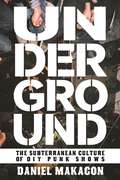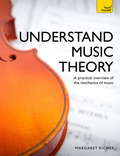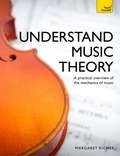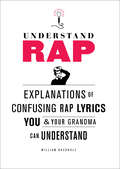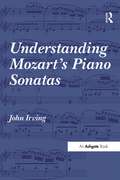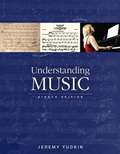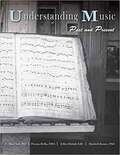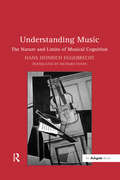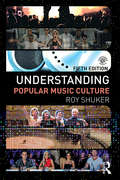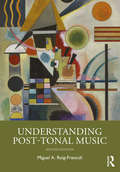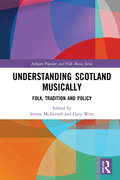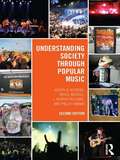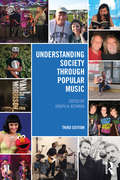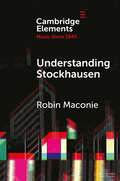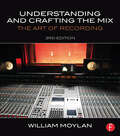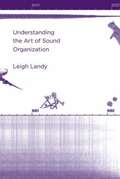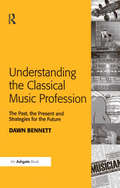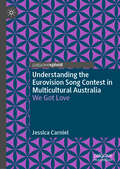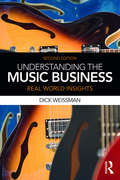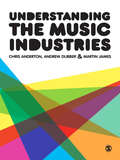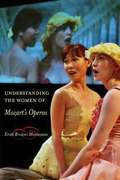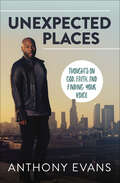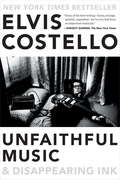- Table View
- List View
Underground: The Subterranean Culture of DIY Punk Shows
by Daniel MakagonUnderground is all about the history and future of DIY punk touring in the USA. Daniel Makagon explores the culture of DIY spaces like house shows and community-based music spaces, their impact on underground communities and economies, and why these networks matter. He shows that no matter who you are, organizing, playing, and/or attending a DIY punk show is an opportunity to become a real part of a meaningful movement and to create long-lasting alternatives to the top-down economic and artistic practices of the mainstream music industry. Punk kids playing an illegal show too loudly in someone's basement might not save the world, but they might just be showing us the way to building something better.
Understand Music Theory: Teach Yourself (Teach Yourself Music Ser.)
by Margaret RicherUnderstand Music Theory is a practical approach that uses active learning to impart knowledge. Suitable for complete beginners, and assuming no previous knowledge, each chapter includes examples, illustrations, clear explanations, tips and self-tests before moving on. It covers all the essential topics in music theory, from rhythm and pitch to intervals, major and minor scales and compound time signatures. It also goes beyond these basic concepts to more advanced theory such as harmony, tone colour and musical form, to provide a genuinely comprehensive introduction to music theory.The theoretical information is all backed up by plenty of practical exercises, and the book includes accompnying audio on the Teach Yourself Library with further practice activities, to really consolidate your knowledge.
Understand Music Theory: Teach Yourself (Teach Yourself Music Ser.)
by Margaret RicherUnderstand Music Theory offers a practical approach which uses active learning to impart knowledge. Suitable for complete beginners and assuming no previous experience, each chapter includes diagrams, examples, clear explanations, helpful hints and self-tests before moving on, which help create a sense of achievement as you make your way through the book. With results that will get you enjoying your music even more, this is an invaluable guide to understanding music theory.NOT GOT MUCH TIME?One, five and ten-minute introductions to key principles to get you started.AUTHOR INSIGHTSLots of instant help with common problems and quick tips for success, based on the authors' many years of experience.TEST YOURSELFTests in the book and online to keep track of your progress.EXTEND YOUR KNOWLEDGEExtra online articles at www.teachyourself.com to give you a richer understanding of music theory.FIVE THINGS TO REMEMBERQuick refreshers to help you remember the key facts.TRY THISInnovative exercises illustrate what you've learnt and how to use it.
Understand Rap: Explanations of Confusing Rap Lyrics that You & Your Grandma Can Understand
by William BuckholzTongue-in-cheek translations of rap lyrics for the clueless!Rap songs are famous for their double entendres, clever turns of phrase, and general ingenuity, but that doesn’t mean things always make sense the first time around. Enter Understand Rap, a funny pop-cultural reference based on the website of the same name, which dryly and precisely explains the confusing lyrics and terms used in rap songs—in language that even the most unhip person can understand! “Where has this book been all our lives?” —Geek Alerts
Understanding Mozart's Piano Sonatas
by John IrvingMozart's piano sonatas are among the most familiar of his works and stand alongside those of Haydn and Beethoven as staples of the pianist's repertoire. In this study, John Irving looks at a wide selection of contextual situations for Mozart's sonatas, focusing on the variety of ways in which they assume identities and achieve meanings. In particular, the book seeks to establish the provisionality of the sonatas' notated texts, suggesting that the texts are not so much identifiers as possibilities and that their identity resides in the usage. Close attention is paid to reception matters, analytical approaches, organology, the role of autograph manuscripts, early editions and editors, and aspects of historical performance practice - all of which go beyond the texts in opening windows onto Mozart's sonatas. Treating the sonatas collectively as a repertoire, rather than as individual works, the book surveys broad thematic issues such as the role of historical writing about music in defining a generic space for Mozart's sonatas, their construction within pedagogical traditions, the significance of sound as opposed to sight in these works (and in particular their sound on fortepianos of the later eighteenth-century) , and the creative role of the performer in their representation beyond the frame of the text. Drawing together and synthesizing this wealth of material, Irving provides an invaluable reference source for those already familiar with this repertoire.
Understanding Music
by Jeremy YudkinUnderstanding Music teaches readers to listen to music with depth, understanding, and knowledge. Using music as a tool to exercise listening skills, the Eighth Edition integrates lively text, clear listening guides, and hands-on videos and web activities to convey the importance of listening. Through exploring and understanding different music from all around the world, Understanding Music teaches readers how to appreciate music concepts and styles, as well as gain important listening skills they can exercise in all areas of life.
Understanding Music: Past and Present
by N. Alan Clark Thomas Heflin Jeffrey Kluball Elizabeth KramerThe benefits of music in our lives are increasingly acknowledged by researchers and scientist. As human beings, we have taken the existence of music for granted and rarely think critically about music and its purpose. Perhaps for this reason, such critical thinking about music is sometimes perceived as difficult. Understanding Music: Past and Present creates a roadmap from some of the earliest known origins of music to modern day. This linear approach allows the reader to trace the history and evolution of music through the ages. Understanding Music: Past and Present is designed to grow the reader’s appreciation of music through improved understanding and listening skills, allowing the reader to develop his or her own informed opinions and express them. <p><p> Sponsored by eCore: eCore is a collaborative program that supports online core courses for students from twenty-five University System of Georgia colleges and universities. In an effort to decrease out-of-pocket costs for students in higher education, eCore Curriculum & Instruction has made great strides over the last few years to design, develop, and adopt Open Educational Resources into the curriculum offerings. eCore partners with the University of North Georgia Press and Affordable Learning Georgia to provide no-cost and low-cost textbooks and materials to its students. OERs are currently available in most of eCore’s twenty-six course offerings, with a goal to implement OERs into 100% of the course offerings.
Understanding Music: The Nature and Limits of Musical Cognition
by HansHeinrich EggebrechtIn an age when our patterns of music consumption are changing rapidly, musical understanding has never been more relevant. Understanding Music provides readers with an ideal entry point to the topic, addressing 'both the music lover who has made listening to music an important part of his life and at the same time is willing to reflect on music and his encounter with it, as well as the more academically-minded enthusiast and the thoughtful expert.' Its author, Hans Heinrich Eggebrecht, was one of the most influential German musicologists of the twentieth century and yet he is almost unknown to English readers. His published work stretches from one end of the musicological spectrum to the other, with research on historical topics in early music, Bach, Beethoven reception, Mahler and music aesthetics all featuring. Understanding Music summarizes Eggebrecht's thoughts on the relationship between music and cognition. As he says in his preface, the purpose of his book is 'to direct the reader towards the fundamental issues and processes implied in understanding music. What does understanding mean when applied to music? How is the process to be described? What different kinds of understanding are to be distinguished here? What other concepts are implicit in and related to the concept of understanding? How is the relationship between music and the listener who understands it to be articulated? What might correct understanding of music mean given music's multiplicity of meaning and effect? Where are the limits of understanding and what lies beyond? What role do language and history play?'. Eggebrecht's answers to these and other questions amount to a compelling account of how the mind grasps the sounds of music in themselves and what other factors contribute to music's meaning so much to us as listeners.
Understanding Popular Music Culture
by Roy ShukerThis extensively revised and expanded fifth edition of Understanding Popular Music Culture provides an accessible and comprehensive introduction to the production, distribution, consumption and meaning of popular music, and the debates that surround popular culture and popular music. Reflecting the continued proliferation of popular music studies, the new music industry in a digital age, and the emergence of new stars, this new edition has been reorganized and extensively updated throughout, making for a more coherent and sequenced coverage of the field. These updates include: two new chapters entitled 'The Real Thing': Authenticity, covers and the canon and 'Time Will Pass You By': Histories and popular memory new case studies on artists including The Rolling Stones, Lorde, One Direction and Taylor Swift further examples of musical texts, genres, and performers throughout including additional coverage of Electronic Dance Music expanded coverage on the importance of the back catalogue and the box set; reality television and the music biopic greater attention to the role and impact of the internet and digital developments in relation to production, dissemination, mediation and consumption; including the role of social network sites and streaming services each chapter now has its own set of expanded references to facilitate further investigation. Additional resources for students and teachers can also be found on the companion website (www.routledge.com/cw/shuker), which includes additional case studies, links to relevant websites and a discography of popular music metagenres.
Understanding Post-Tonal Music
by Miguel A. Roig-FrancolíUnderstanding Post-Tonal Music is a student-centered textbook that explores the compositional and musical processes of twentieth-century post-tonal music. Intended for undergraduate or general graduate courses on the theory and analysis of twentieth-century music, this book will increase the accessibility of post-tonal music by providing students with tools for understanding pitch organization, rhythm and meter, form, texture, and aesthetics. By presenting the music first and then deriving the theory, Understanding Post-Tonal Music leads students to greater understanding and appreciation of this challenging and important repertoire. The updated second edition includes new "Explorations" features that guide students to engage with pieces through listening and a process of exploration, discovery, and discussion; a new chapter covering electronic, computer, and spectral musics; and additional coverage of music from the twenty-first century and recent trends. The text has been revised throughout to enhance clarity, both by streamlining the prose and by providing a visual format more accessible to the student.
Understanding Scotland Musically: Folk, Tradition and Policy (Ashgate Popular and Folk Music Series)
by Gary West Simon McKerrellScottish traditional music has been through a successful revival in the mid-twentieth century and has now entered a professionalised and public space. Devolution in the UK and the surge of political debate surrounding the independence referendum in Scotland in 2014 led to a greater scrutiny of regional and national identities within the UK, set within the wider context of cultural globalisation. This volume brings together a range of authors that sets out to explore the increasingly plural and complex notions of Scotland, as performed in and through traditional music. Traditional music has played an increasingly prominent role in the public life of Scotland, mirrored in other Anglo-American traditions. This collection principally explores this movement from historically text-bound musical authenticity towards more transient sonic identities that are blurring established musical genres and the meaning of what constitutes ‘traditional’ music today. The volume therefore provides a cohesive set of perspectives on how traditional music performs Scottishness at this crucial moment in the public life of an increasingly (dis)United Kingdom.
Understanding Society through Popular Music
by Joe Kotarba Bryce Merrill Phillip Vannini J Patrick WilliamsWritten for Introductory Sociology and Sociology of Popular Music courses, the second edition of Understanding Society through Popular Music uses popular music to illustrate fundamental social institutions, theories, sociological concepts, and processes. The authors use music, a social phenomenon of great interest, to draw students in and bring life to their study of sociology. The new edition has been updated with cutting edge thinking on and current examples of subcultures, politics, and technology.
Understanding Society through Popular Music
by Joseph A. KotarbaWritten for Introductory Sociology and Sociology of Popular Music courses, this book uses popular music to illustrate fundamental social institutions, theories, sociological concepts, and processes. The authors use music, a social phenomenon of great interest, to draw students in and bring life to their study of social life.
Understanding Stockhausen (Elements in Music since 1945)
by Robin MaconieThis collection of essays addresses technical developments in telecommunications and sound recording that have guided the direction of musical aesthetics in the post-1950 era. Such information is readily available online but may appear counterintuitive to many who find its priorities difficult to grasp from a musical perspective. The author hopes to draw attention to the place of ideas of communication and flight in western tradition. This Element begins with Varèse and his 'noble noise', traverses the arrival of Information Theory and its influence, examples of early computer music, and ends with a defence of the sublime logic of Stockhausen's singing helicopters and tornados.
Understanding Video Game Music
by Tim Summers James HanniganUnderstanding Video Game Music develops a musicology of video game music by providing methods and concepts for understanding music in this medium. From the practicalities of investigating the video game as a musical source to the critical perspectives on game music - using examples including Final Fantasy VII, Monkey Island 2, SSX Tricky and Silent Hill - these explorations not only illuminate aspects of game music, but also provide conceptual ideas valuable for future analysis. Music is not a redundant echo of other textual levels of the game, but central to the experience of interacting with video games. As the author likes to describe it, this book is about music for racing a rally car, music for evading zombies, music for dancing, music for solving puzzles, music for saving the Earth from aliens, music for managing a city, music for being a hero; in short, it is about music for playing.
Understanding and Crafting the Mix: The Art of Recording (The\art Of Recording Ser.)
by William MoylanUnderstanding and Crafting the Mix, 3rd edition provides the framework to identify, evaluate, and shape your recordings with clear and systematic methods. Featuring numerous exercises, this third edition allows you to develop critical listening and analytical skills to gain greater control over the quality of your recordings. Sample production sequences and descriptions of the recording engineer’s role as composer, conductor, and performer provide you with a clear view of the entire recording process. Dr. William Moylan takes an inside look into a range of iconic popular music, thus offering insights into making meaningful sound judgments during recording. His unique focus on the aesthetic of recording and mixing will allow you to immediately and artfully apply his expertise while at the mixing desk. A companion website features recorded tracks to use in exercises, reference materials, additional examples of mixes and sound qualities, and mixed tracks.
Understanding the Art of Sound Organization
by Leigh LandyThe first work to propose a comprehensive musicological framework to study sound-based music, a rapidly developing body of work that includes electro-acoustic art music, turntable composition, and acoustic and digital sound installations.
Understanding the Classical Music Profession: The Past, the Present and Strategies for the Future
by Dawn Elizabeth BennettUnderstanding the Classical Music Profession is an essential resource for educators, practitioners and researchers who seek to understand the careers of classically-trained musicians, and the extent to which professional practice is reflected within existing classical performance-based music education and training. Taking Australia as a case-study, Dawn Bennett outlines how Australia is now a service economy, and an important component of service provision is in the culture and recreation industries. Despite this, employment in culture and recreation is poorly understood and a lack of cultural intelligence contributes to a less than satisfactory environment that inhibits the creative potential of cultural practitioners. Musicians in the twenty-first century require a broad and evolving base of skills and knowledge to sustain their careers as cultural practitioners. Bennett maintains that a musician cannot be simply defined as a performer, but that a musician is someone who works within the profession of music in one or more specialist fields. The perception of a musician as a multi-skilled professional working within a portfolio career has significant implications for policy, funding, education and training, and for practitioners and students seeking to achieve sustainable careers. This indispensable book provides a comprehensive analysis of life as a musician, from education and training to professional practice as well as revealing the structure of the Australian cultural industries. Although Australia is the focus of the book, the basis of the research originates from many different places and most of the issues discussed relate directly to other countries throughout the world.
Understanding the Eurovision Song Contest in Multicultural Australia
by Jessica CarnielThis book presents the first in-depth study of the Eurovision Song Contest from an Australian perspective. Using a cultural studies approach, the study draws together fan interviews and surveys with media and textual analysis of the contest itself. In doing so, it begins to answer the question of why the European song contest appeals to viewers in Australia. It explores and challenges the dominant narrative that links Eurovision fandom to post-WWII European migration, arguing that this Eurocentric narrative presents a limited view of how contemporary Australian multicultural society operates in the context of globalized culture. It concludes with a consideration of the future of the Eurovision Song Contest as Australia enters into the ‘Asian century’.
Understanding the Leitmotif
by Matthew Bribitzer-StullThe musical leitmotif, having reached a point of particular forcefulness in the music of Richard Wagner, has remained a popular compositional device up to the present day. In this book, Matthew Bribitzer-Stull explores the background and development of the leitmotif, from Wagner to the Hollywood adaptations of The Lord of The Rings and the Harry Potter series. Analyzing both concert music and film music, Bribitzer-Stull explains what the leitmotif is and establishes it as the union of two aspects: the thematic and the associative. He goes on to show that Wagner's Ring cycle provides a leitmotivic paradigm, a model from which we can learn to better understand the leitmotif across style periods. Arguing for a renewed interest in the artistic merit of the leitmotif, Bribitzer-Stull reveals how uniting meaning, memory, and emotion in music can lead to a richer listening experience and a better understanding of dramatic music's enduring appeal.
Understanding the Music Business: Real World Insights
by Dick WeissmanIn today’s fast-moving music industry, what does it take to build a life-long career? Now more than ever, all those working in music need to be aware of many aspects of the business, and take control of their own careers. Understanding the Music Business offers students a concise yet comprehensive overview of the rapidly evolving music industry, rooted in real-world experiences. Anchored by a wealth of career profiles and case studies, this second edition has been updated throughout to include the most important contemporary developments, including the advent of streaming and the shift to a DIY paradigm. A new "Both Sides Now" feature helps readers understand differing opinions on key issues. Highly readable, Understanding the Music Business is the perfect introduction for anyone seeking to understand how musical talents connect to making a living.
Understanding the Music Industries
by Andrew Dubber Chris Anderton Martin JamesEveryone knows music is big business, but do you really understand how ideas and inspiration become songs, products, downloads, concerts and careers? This textbook guides students to a full understanding of the processes that drive the music industries. More than just an expose or 'how to' guide, this book gives students the tools to make sense of technological change, socio-cultural processes, and the constantly shifting music business environment, putting them in the front line of innovation and entrepreneurship in the future. Packed with case studies, this book: * Takes the reader on a journey from Glastonbury and the X-Factor to house concerts and crowd-funded releases; * Demystifies management, publishing and recording contracts, and the world of copyright, intellectual property and music piracy; * Explains how digital technologies have changed almost all aspects of music making, performing, promotion and consumption; * Explores all levels of the music industries, from micro-independent businesses to corporate conglomerates; * Enables students to meet the challenge of the transforming music industries. This is the must-have primer for understanding and getting ahead in the music industries. It is essential reading for students of popular music in media studies, sociology and musicology.
Understanding the Women of Mozart's Operas
by Kristi Brown-MontesanoIs The Marriage of Figaro just about Figaro? Is Don Giovanni's story the only one--or even the most interesting one--in the opera that bears his name? For generations of critics, historians, and directors, it's Mozart's men who have mattered most. Too often, the female characters have been understood from the male protagonist's point of view or simply reduced on stage (and in print) to paper cutouts from the age of the powdered wig and the tightly cinched corset. It's time to give Mozart's women--and Mozart's multi-dimensional portrayals of feminine character--their due. In this lively book, Kristi Brown-Montesano offers a detailed exploration of the female roles in Mozart's four most frequently performed operas, Le nozze di Figaro, Don Giovanni, Cosigrave; fan tutte, and Die Zauberflouml;te. Each chapter takes a close look at the music, libretto text, literary sources, and historical factors that give shape to a character, re-evaluating common assumptions and proposing fresh interpretations. Brown-Montesano views each character as the subject of a story, not merely the object of a hero's narrative or the stock figure of convention. From amiable Zerlina, to the awesome Queen of the Night, to calculating Despina, all of Mozart's women have something unique to say. These readings also tackle provocative social, political, and cultural issues, which are used in the operas to define positive and negative images of femininity: revenge, power, seduction, resistance, autonomy, sacrifice, faithfulness, class, maternity, and sisterhood. Keenly aware of the historical gap between the origins of these works and contemporary culture, Brown-Montesano discusses how attitudes about such concepts--past and current--influence our appreciation of these fascinating representations of women.
Unexpected Places: Thoughts on God, Faith, and Finding Your Voice
by Anthony EvansUnexpected Places is the personal story of gospel singer Anthony Evans, son of well-known pastor Tony Evans and brother of author Priscilla Shirer. In this intimate and moving memoir, Anthony shares the details of his struggles with depression and doubt, and encourages readers with the unique story of his search for purpose and identity. From growing up duty-bound to his name, to his time as a finalist and then talent producer on The Voice, Anthony explores the pressures he experienced as a child and as a young man in Hollywood. He describes the journey to his renewed faith in God and exposes the vast differences between what the world teaches us to value and how God values us. Anthony examines what his parents did right in raising him but also describes how they unknowingly missed his pain. Finally, he reveals how God orchestrated His plan to grow Anthony into a man who is in love with his life, his heritage, and his individual calling.Anthony has learned to embrace the incredible beauty of his unique voice. In Unexpected Places, he invites readers on their own journey to do the same.
Unfaithful Music & Disappearing Ink
by Elvis CostelloBorn Declan Patrick MacManus, Elvis Costello was raised in London and Liverpool, grandson of a trumpet player on the White Star Line and son of a jazz musician who became a successful radio dance-band vocalist. <P><P>Costello went into the family business and before he was twenty-four took the popular music world by storm.Costello continues to add to one of the most intriguing and extensive songbooks of our day. His performances have taken him from strumming a cardboard guitar in his parents' front room to fronting a rock and roll band on our television screens and performing in the world's greatest concert halls in a wild variety of company. Unfaithful Music & Disappearing Ink describes how Costello's career has endured for almost four decades through a combination of dumb luck and animal cunning, even managing the occasional absurd episode of pop stardom.This memoir, written entirely by Costello, offers his unique view of his unlikely and sometimes comical rise to international success, with diversions through the previously undocumented emotional foundations of some of his best-known songs and the hits of tomorrow. It features many stories and observations about his renowned cowriters and co-conspirators, though Costello also pauses along the way for considerations of the less appealing side of fame. <P>Unfaithful Music & Disappearing Ink provides readers with a master's catalogue of a lifetime of great music. Costello reveals the process behind writing and recording legendary albums like My Aim Is True, This Year's Model, Armed Forces, Almost Blue, Imperial Bedroom, and King of America. He tells the detailed stories, experiences, and emotions behind such beloved songs as "Alison," "Accidents Will Happen," "Watching the Detectives," "Oliver's Army," "Welcome to the Working Week," "Radio Radio," "Shipbuilding," and "Veronica," the last of which is one of a number of songs revealed to connect to the lives of the previous generations of his family.Costello recounts his collaborations with George Jones, Chet Baker, and T Bone Burnett, and writes about Allen Toussaint's inspiring return to work after the disasters following Hurricane Katrina. He describes writing songs with Paul McCartney, the Brodsky Quartet, Burt Bacharach, and The Roots during moments of intense personal crisis and profound sorrow. He shares curious experiences in the company of The Clash, Tony Bennett, The Specials, Van Morrison, and Aretha Franklin; writing songs for Solomon Burke and Johnny Cash; and touring with Bob Dylan; along with his appreciation of the records of Frank Sinatra, David Bowie, David Ackles, and almost everything on the Tamla Motown label.Costello chronicles his musical apprenticeship, a child's view of his father Ross MacManus' career on radio and in the dancehall; his own initial almost comical steps in folk clubs and cellar dive before his first sessions for Stiff Record, the formation of the Attractions, and his frenetic and ultimately notorious third U.S. tour. He takes readers behind the scenes of Top of the Pops and Saturday Night Live, and his own show, Spectacle, on which he hosted artists such as Lou Reed, Elton John, Levon Helm, Jesse Winchester, Bruce Springsteen, and President Bill Clinton. The idiosyncratic memoir of a singular man, Unfaithful Music & Disappearing Ink is destined to be a classic.From the Hardcover edition.
